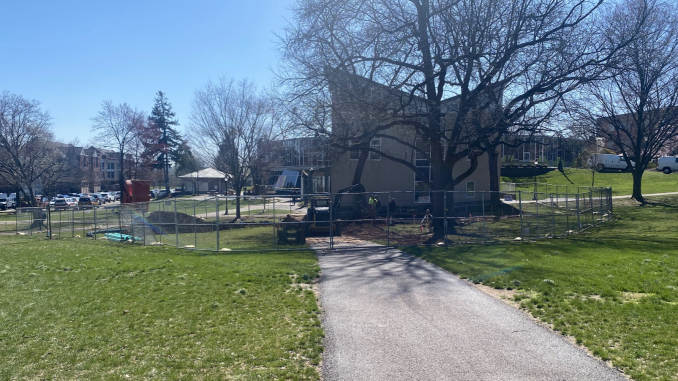
Erin Corcoran ercorcoran@ursinus.edu
A new rain garden is being installed on Ursinus’s campus alongside the path between Lower Wismer and the Kaleidoscope. When fully installed, the rain garden will help prevent the puddling that commonly occurs on the pathway. This project was conceptualized in the Spring 2022 semester by Dr. Finney’s Plant Biology class where students identified the area as an on-campus source that could benefit from native plants.
Over the summer and fall, a group of interested students and organizations worked out the details and began to make the rain garden a reality. It is a collaborative project between Ursinus’s Biology Department, Office of Sustainability, and the Facilities Department, as well as the Perkiomen Watershed Conservancy and Woodrow & Associates Inc. Overseeing the project are student environmental leaders Nate Berger ’23, Evan Stinson ’23, Hannah Blanco ’24, and Andrew Philburn ’25.
Kate Keppen, the director of the Office of Sustainability, explains how it works: “[Rain gardens] are constructed in a certain way so that water is encouraged to flow into the garden. In fact, rain gardens are usually a depression in the land or are formed in the shape of a bowl. The soil of a rain garden is important and is usually a careful mix of sand and soil to allow water to be absorbed into the ground. It is important for the Ursinus community to know we are not building a pond. When it rains, the water that would flow over the land and end up puddling on the walkway will now flow into the garden. The water may pool in the garden for about 24 hours, and then it will be absorbed into the ground and used by the plants.”
Keppen explained that the rain garden not only prevents the walkway from flooding, but it will also contribute to the water cycle by filtering water shallowly into the ground. Native plants will grow in the garden, which are acclimated to the local climate as well as attract pollinators and maintain biodiversity. This will be the second native plant garden on campus, as one previously conceptualized by Dr. Woodstock’s class is located nearby as well.
The garden does not only benefit the environment, as the team involved hopes that this area will become a communal gathering space for the Ursinus community, along with providing ways for the campus community to learn more about the surrounding environment. Future plans include adding identification cards to the plants, and the team is also working with Facilities to create sitting areas nearby.
One of the student organizers, Evan Stinson ’23, states, “I’m excited to see [the plants] in full bloom and to hear these become a point of conversation for people on campus. There is a whole world of life that I only saw as ‘weeds’ prior to this project, so I hope this project contributes to expanding people’s awareness of the landscape all around them.”
Currently, the project is slated to be completed by mid-April, weather dependent. Keep an eye out for emails regarding opportunities to assist in planting native plants in the new rain garden and other ways to partake in this new addition to campus. Email sustainability@ursinus.edu or kkep- pen@ursinus.edu to find out how you can get involved!
